Affiliate disclosure: This post may contain affiliate links. Please see our Privacy Policy.
Ground cherry wine is a tropical treat for northern gardeners, and it gives you a delicious sweet pineapple/strawberry-flavored drink in a glass. Sometimes called husk cherries, these little yellow fruits look like yellow cherries with husks, but they grow on a plant that’s kind of like a tomato vine.

Ground cherry wine is a spectacular way to use frozen ground cherries from summer and fall. These fruits lend a beautiful tropical flavor to wines, blending their pineapple and berry characteristics for a perfectly balanced wine or mead.
Ground cherries (also called husk cherries or cape gooseberries) are becoming more well-known to Northern gardeners. Their distinct flavor is something like a blend between a pineapple and a strawberry.
Growing ground cherries is a great way to ensure a reliable crop year after year.
Ground cherries (Physalis pruinosa) are part of the nightshade family along with eggplants, tomatoes and peppers. However, they taste nothing like their Solanaceae cousins. These tropical-tasting fruits are ripe once the husks dry and they begin to drop, usually in late summer and throughout the fall. Collecting and fermenting these fruits will lead to a delicious summertime sipper filled with tropical nuances.
When making ground cherry wine, you’ll follow the same steps as when tackling any small-batch country wine.
You’ll include the fruit in a primary ferment, along with some sugar or honey for sweetness, and a few winemaking additives to help balance the flavors. Lastly, a nice strain of yeast will ensure everything goes according to plan!
You’ll let this mixture ferment for 7 to 10 days until the active fermentation has slowed. After siphoning to a new vessel and leaving the fruit behind, you’ll allow the wine to ferment at a slower rate in a dark and cool location for anywhere from 1 month to 6 months.
Now, all that’s needed is bottling the wine and letting it mature for a few weeks (or months) before enjoying it. Easy peasy!
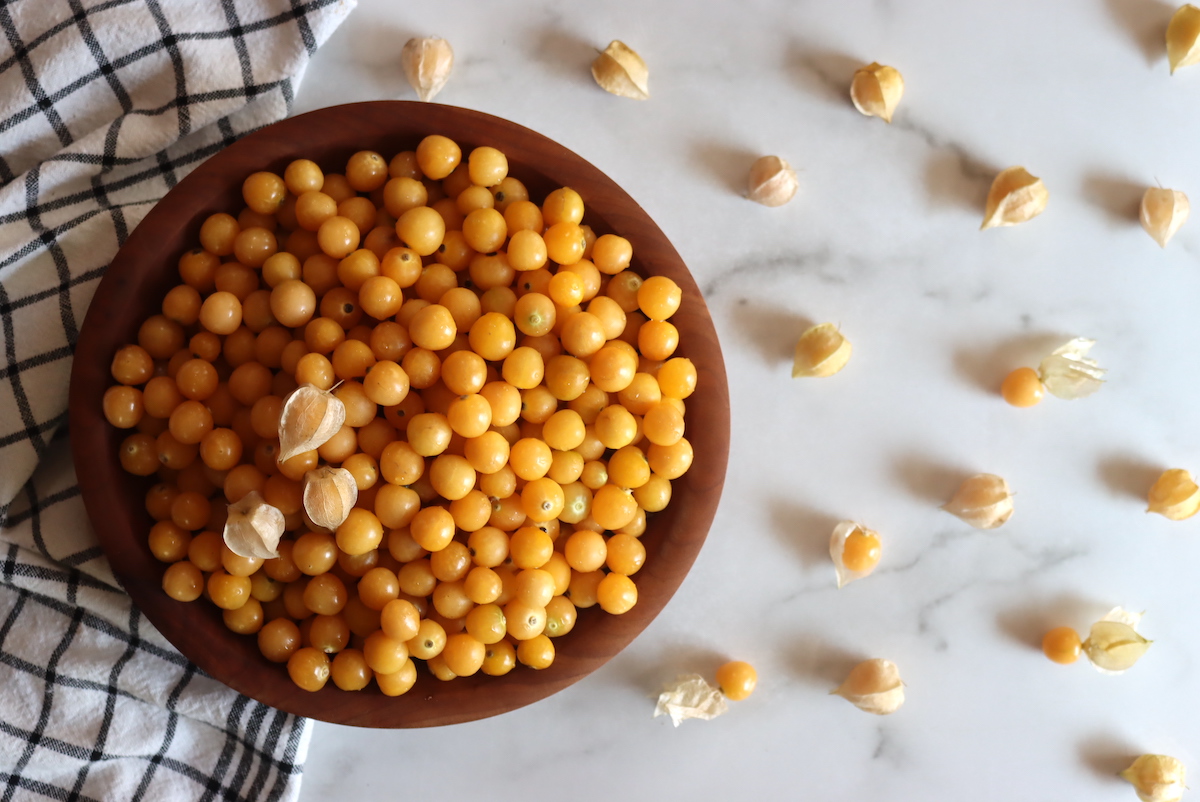
As for the recipe, I’ve written it out assuming you understand the rudimentary steps of winemaking and associated terms. For anyone new to winemaking, I have a few introductory guides to help you:
- Beginners Guide to Making Fruit Wines will take you through the basic winemaking process step by step.
- How to Make Mead (Honey Wine) is pretty similar, but describes some of the subtleties when using honey.
- Equipment for Winemaking will tell you all about the equipment needed (besides your ingredients) to make your first batch.
- Ingredients for Winemaking will outline everything else needed (other than yeast).
- Yeast for Winemaking covers all the most common yeast strains and how to pick the right one.
Ingredients for Ground Cherry Wine
To make ground cherry wine, you’ll need just a few ingredients. These will be easy to source, but for anyone new to winemaking, you’ll likely want to read this quick guide on winemaking ingredients — it will explain what each of these ingredients does in the winemaking process.
To make a one-gallon batch of ground cherry wine, you will need:
- 3 lbs ground cherries (husks removed)
- 2 lbs sugar
- 1 tsp Yeast Nutrient
- 1 tsp Acid Blend
- ¼ tsp Wine Tannin
- ½ tsp Pectic Enzyme
- Wine Yeast (preferably Lalvin 71B)
- Water to fill
If you don’t happen to have these ingredients on hand, you can purchase an acid blend, wine tannin and pectic enzyme in a kit altogether and then all you’ll need is a yeast nutrient and wine yeast.
Although ground cherries may taste astringent, they aren’t very acidic in terms of PH, so you’ll need to add a teaspoon of acid blend to help boost the tropical flavors in your wine and bring out those pineapple notes. Additionally, adding ¼ teaspoon of tannin powder is needed (since ground cherries have no detectable tannins in the fruit) and will give the wine a more balanced mouthfeel.
Ground cherries don’t have a ton of pectin so only a ½ teaspoon of pectic enzyme will be needed to help clear the wine
As for wine yeast, Lalvin 71B is a nice choice. Lalvin 71B will enhance the fruit flavors of wine while helping to neutralize the sour notes caused by malic acid. As a result, it leads to smoother wines and a softer mouthfeel. Alcohol tolerance to 14%.
Apart from these wine-making ingredients, some equipment will also be needed. This includes:
- One Gallon Wide-Mouth Carboy for primary fermentation
- One Gallon Narrow-Neck Carboy for secondary fermentation (generally sold in a kit with a rubber stopper and water lock together)
- Rubber Stopper and Water Lock (if not included above)
- Brewing Siphon
- Wine bottles or Flip-top Grolsch bottles
- Bottle Corker and clean, new corks for bottling
- Brewing Sanitizer
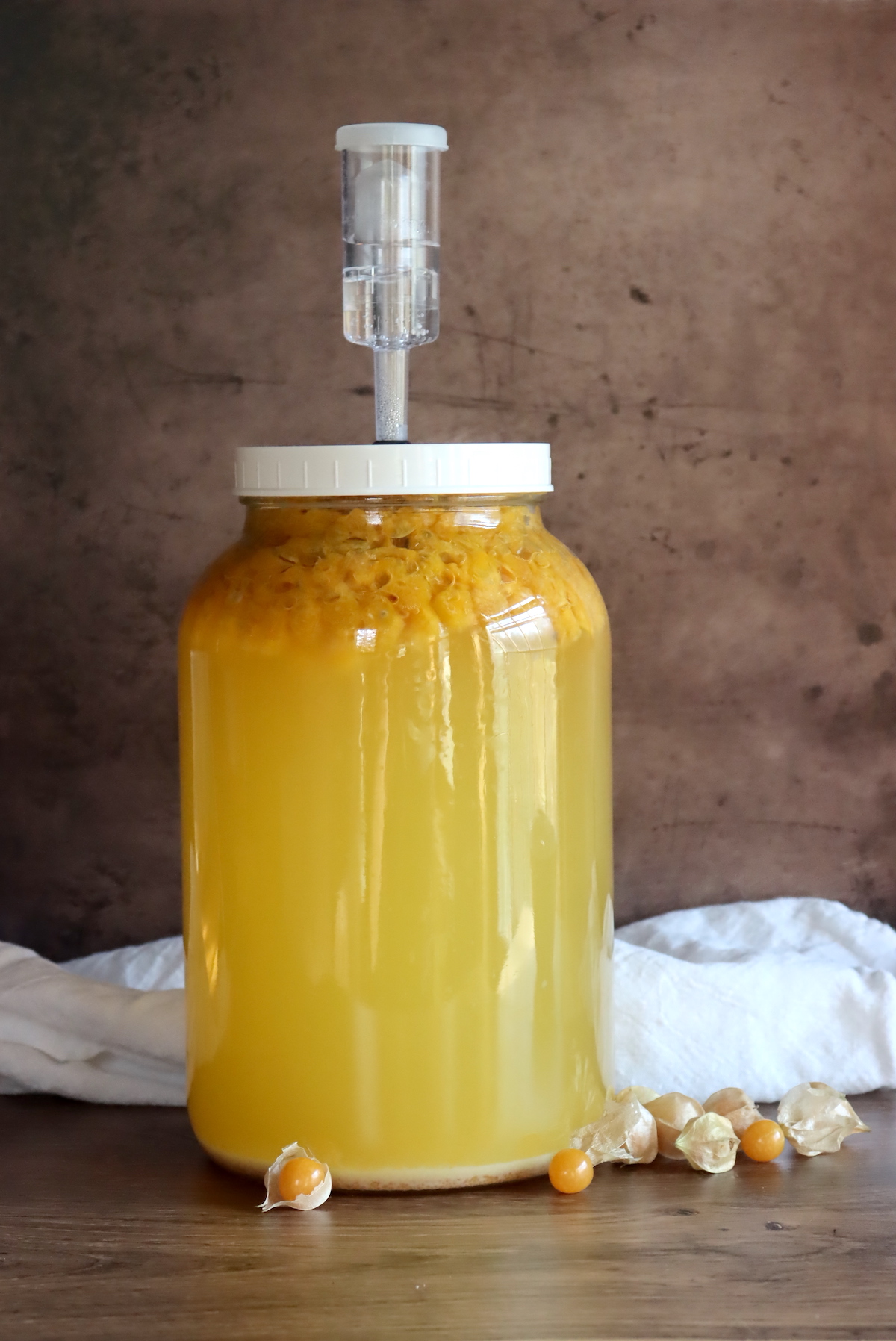
Making Ground Cherry Wine
When making ground cherry wine, you’ll need about 3 pounds of fruit. Ground cherries can be dry, so freezing the fruit first is recommended to help break them down.
Be sure to remove the husk from your ground cherries before freezing. Defrost when ready to use and place thawed fruit in a wide-mouth carboy for primary fermentation.
Dissolve the sugar into water on the stovetop and add to the carboy. Let cool and add the acid blend, wine tannin, pectic enzyme and yeast nutrient. Save the wine yeast for last.
Before adding, rehydrate yeast in a little bit of room temperature water. Add the yeast to your mixture and finish by topping with enough water to leave 2 inches of headspace.
Seal with a water lock so your fermenting CO2 can escape without letting other contaminants in. In a day or two, a nice active bubbling should be visible.
Let the ground cherry wine ferment until you see the bubbling has mostly stopped (about 7 to 10 days). Now it is time to move the wine to a clean fermentation vessel, leaving the fruit and sediment behind.
Siphon the wine to a clean carboy to avoid stirring up sediment and top with more water to bring up the water level. Seal with a water lock and let the wine ferment for at least another 4 weeks (and at least 8 weeks for husk cherry mead).
For mead, the time spent in secondary ranges from 2 to 6 months as honey takes a longer time to ferment. This is because honey is less digestible than regular sugar is for the yeast.
Towards the end of secondary, be sure to sample the wine — although it’s still a little rough at this state, you should still be able to taste a balanced wine with just enough sweetness. If not, adjust to your taste.
If you decide to backsweeten, rack the wine to a clean vessel and create a simple syrup by mixing 1 part sugar and 1 part water stovetop. Be sure to stabilize the wine 24 to 48 hours in advance by adding 1 Campden tablet (sodium metabisulfite) and ½ teaspoon potassium sorbate to kill off the yeast.
If this is skipped, the sugar may reactivate the yeast, causing a rapid ferment and your bottled wine to burst.
Put back into ferment for another week or 2 before bottling. When ready, bottle the wine and allow it to mature for at least a month or so before drinking. Wines improve with age, so let those flavors develop!
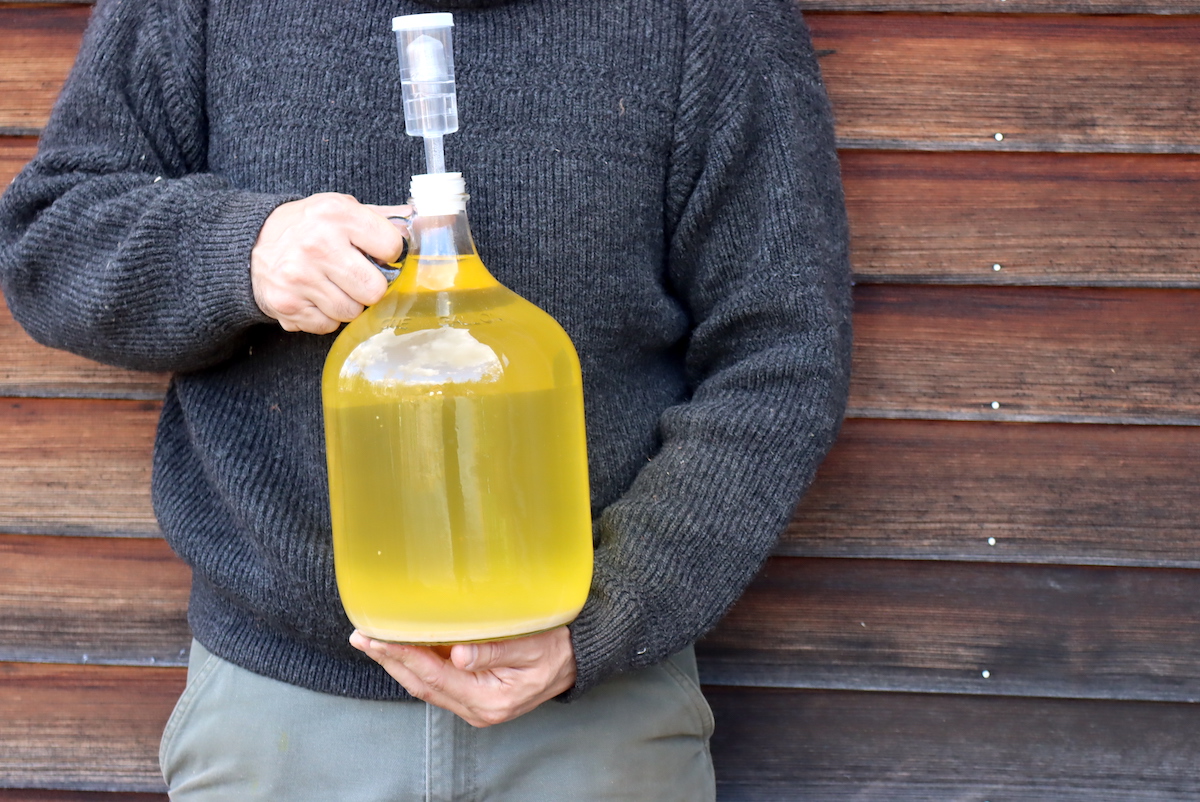
Ways to Preserve Ground Cherries
In search of more ways to use up that stockpile of ground cherries?
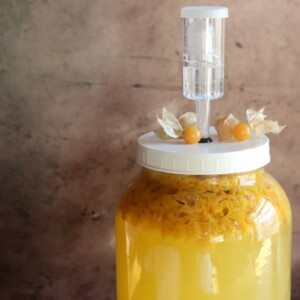
Ground Cherry Wine (and Mead)
Ingredients
- 3 lbs ground cherries, husks removed
- 2 pounds Sugar, about 4 cups
- 1 tsp yeast nutrient
- 1 tsp acid blend
- ½ tsp Pectic Enzyme
- ¼ tsp tannin powder
- wine yeast, see note
- Water to fill
- Optional ~ Campden Tablet and Potassium Sorbate for Stabilizing, only necessary for backsweetening
Instructions
- Remove husks from ground cherries and freeze fruit.
- When ready, thaw ground cherries and move to a wide-mouth carboy.
- Dissolve sugar in water and pour over the fruit. Add acid blend, pectic enzyme, wine tannin and yeast nutrient and stir to mix.
- Rehydrate your wine yeast in a bit of room temperature water for 10 minutes before adding it to your wine. (Always add wine yeast last.)
- Top with enough water to leave 2 inches of headspace and seal with a water lock.
- Ferment in primary until you see fermentation slow and stop. (About 7 to 10 days.)
- Siphon wine to a clean fermentation vessel for secondary, leaving fruit behind, and add enough water to bring the level to just below the neck of the carboy.
- Seal with a water lock and ferment in secondary at least 4 weeks for wine and 8 weeks for mead.
- Taste the wine and adjust as necessary. See notes for backsweetening.
- Bottle your wine with fresh corks and allow it to age for at least a month before drinking.
Notes
Fruit
You’ll need about 3 pounds of ground cherries to make a nice flavorful batch of ground cherry wine. Fruit is best frozen for around a week before making wine. Freezing helps to break down the fruit and their pectin content.Yeast
For ground cherry wine, you'll need a wine yeast with a moderate alcohol tolerance. Lalvin 71B is a nice choice for ground cherry wine, helping to mellow flavors and enhance the fruity characteristics of the wine.Stabilizing and Back Sweetening
If your wine tastes too dry at the end of secondary, you can always backsweeten it. Be sure to siphon to a new container and stabilize the wine by adding 1 Campden tablet and ½ teaspoon potassium sorbate to kill the yeast. Wait 24 hours before adding sugar to taste. Make a simple syrup of 1 part sugar and 1 part water to sweeten (½ cup sugar is a good place to start for a one-gallon batch of ground cherry wine) and add this to your wine. Put back into ferment for another week or two before bottling.Winemaking Recipes
Looking for more homemade summer wines?
- Blackberry Wine
- Blueberry Wine
- Cherry Wine
- Peach Wine
- Raspberry Wine
- Strawberry Wine
- Watermelon Wine
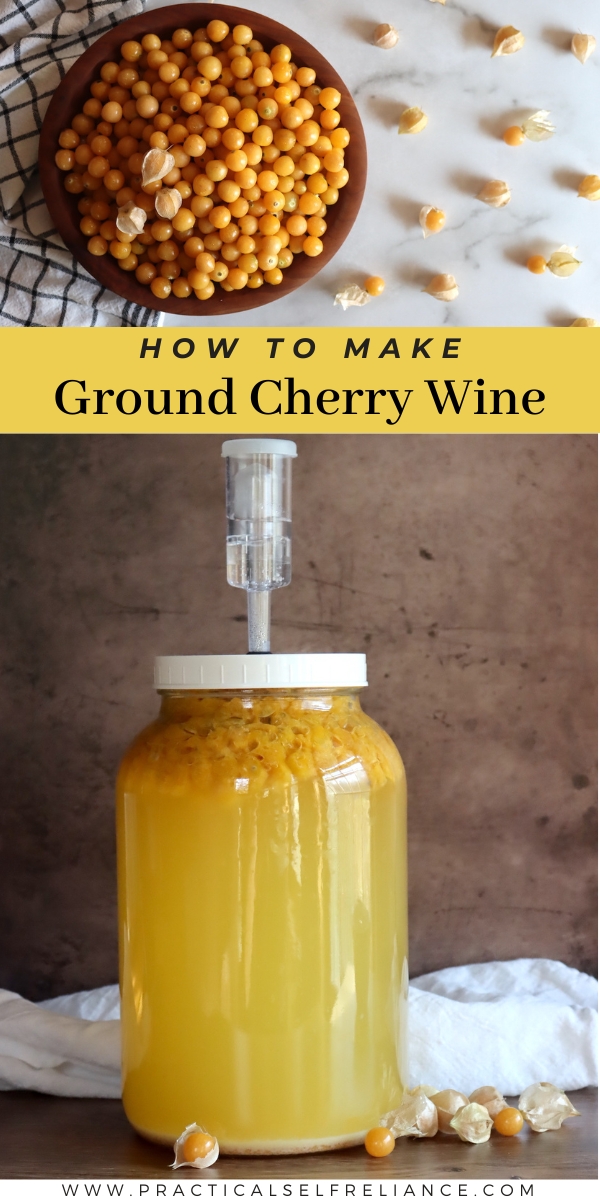



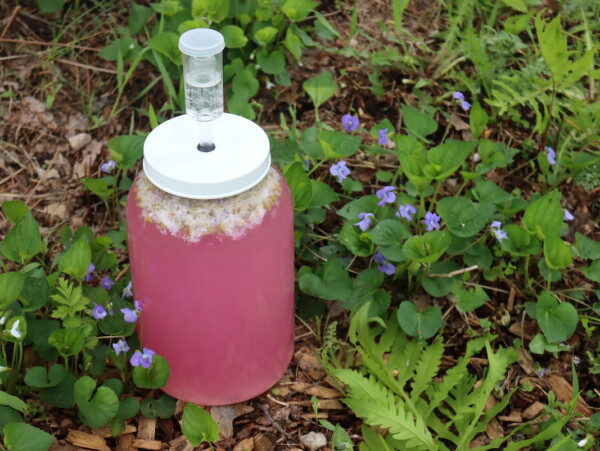










Can I double for the ground cherry? All except yeast
Yes, you can double this recipe, and yes, you’d double everything except the yeast. Enjoy!